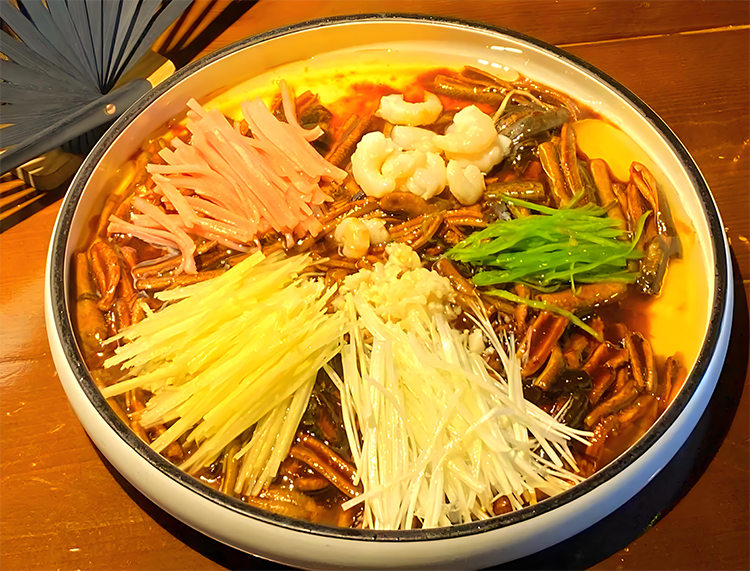Zhejiang Lanhú Eel Threads
1. Zhejiang Lanhú Eel Threads: Gentle Flavors of Jiangnan Watertown
In the tender waterways of Jiangnan, a humble dish turns simplicity into delight: Zhejiang Lanhú eel threads. Less famous than West Lake Fish or Dongpo Pork, this specialty from Huzhou and Jiaxing wins hearts with an exquisitely soft texture and savory, lightly oily flavor. For travelers seeking authentic regional cuisine, a steaming bowl of Lanhú eel threads opens a direct path into Jiangnan’s culinary memory, revealing delicate, comforting tastes that melt on the tongue.
2. Born by the Canals: A True “Kung Fu” Dish
Lanhú eel threads grew up along the dense network of rivers and canals in Jiangnan. Huzhou and Jiaxing, in the Taihu basin, have long been abundant in freshwater eels. Originating as far back as the Ming and Qing eras, local fishermen and cooks refined techniques—especially hand-shredding the eel and the signature “three-oil, three-stir” method—to showcase eel’s natural sweetness. The term “Lanhú” doesn’t mean overcooked mush; it describes a precise soft-but-intact texture achieved through exact heat control. From its start, this dish has been a test of a chef’s skill, a benchmark for Jiangnan culinary craftsmanship.

3. A Cultural Symbol at Festive and Family Tables
In the Huzhou–Jiaxing region, Lanhú eel threads are more than food: they carry emotional meaning. Often featured as a celebratory main at weddings, funerals, and festivals, the dish symbolizes abundance and completeness. At home, a bowl can be simple comfort—an embodiment of family warmth and a mother’s care. For many Jiangnan natives, its flavor equals home; wherever life leads, that spoonful brings a powerful sense of nostalgia and subtle, restrained affection.
4. Fresh Ingredients Build the Flavor Foundation
Authentic Lanhú eel threads start with live, local eels. Jiangnan eels are prized for firm flesh and low fishiness—essential for the dish’s delicate result. Supporting ingredients are modest: lard or local rapeseed oil, Shaoxing yellow wine, soy sauce, ginger, and scallions. The traditional heavy-oil approach—often using rendered pork fat or large amounts of local oil—creates an unctuous mouthfeel that feels rich but not greasy, allowing the eel to dissolve softly on the palate.

5. The Mastery of the “Three-Oil, Three-Stir” Technique
Making Lanhú eel threads is an art centered on two steps: shredding the eel and the three-oil, three-stir technique. First, live eels are briefly blanched, then skillfully sliced into fine, even threads with a specialized bamboo knife—this demands exceptional knife work. Next, the eel is added to a flaming wok in three separate oil additions and three rapid stir-fries: the first stir clears fishiness and sets the shape, the second adds flavor and aroma, and the third thickens and coats the threads with sauce. Every stage—heat, oil temperature, and timing—must be exact. The result is eel that looks glossy outside and becomes luxuriously soft within: broken down but still coherent, rich yet never cloying.
6. The Ultimate Savory, Silky Experience
Tasting Lanhú eel threads is a singular experience. The flavor sits squarely in Jiangnan’s savory-slightly-salty profile: soy sauce depth, Shaoxing wine fragrance, and a ginger-scallion bite blend without overpowering the eel. The texture is the highlight—the threads are so tender they nearly dissolve with little chewing, releasing concentrated juices and the eel’s distinctive sweetness. It’s oily in a pleasing way, leaving a lingering, memorable finish.

7. Traditional Serving and Pairings
Typically presented in a heat-retaining claypot, Lanhú eel threads arrive steaming and aromatic. The classic way to enjoy it is over a bowl of pearly white Jiangnan rice—pour the thick eel and sauce onto rice and stir so every grain is coated; the combination is irresistible. Pairing with a small cup of Shaoxing yellow wine further complements the dish, marrying the food’s savory richness with the wine’s mellow aroma for a full Jiangnan dining experience.
8. Practical Tips for Food Explorers
When visiting Huzhou or Jiaxing, seek out long-established restaurants or well-regarded countryside inns to taste authentic Lanhú eel threads; their chefs typically follow traditional methods. Ask whether the eel is hand-shredded from live fish—”freshly shredded” is the best guarantee of quality. The dish is rich and meant for sharing. Peak season for tasting is summer to autumn, when eels are plump and flavorful.

9. A Simple Home Version to Try
Recreating the full three-oil, three-stir technique at home is challenging, but a simplified version brings Jiangnan flavors to the kitchen. Buy prepared fresh eel threads, stir-fry aromatics (ginger, scallion, garlic), add the eel and flash-cook, then pour in generous Shaoxing wine, soy sauce, and a pinch of sugar. Simmer briefly until tender and thicken the sauce before serving. It won’t match a master chef’s plate, but it offers a heartfelt taste of the watertown region.
Lanhú eel threads represent a regional flavor perfected over time and skill. Born from the rivers of Jiangnan and served at both ordinary and grand tables, the dish concentrates the wetlands’ freshness, moist warmth, and quiet affection into every spoonful. For culinary travelers across China, it offers not only a memorable meal but also an intimate glimpse into local life—seek it out on Jiangnan soil and let the dish warm your journey.


